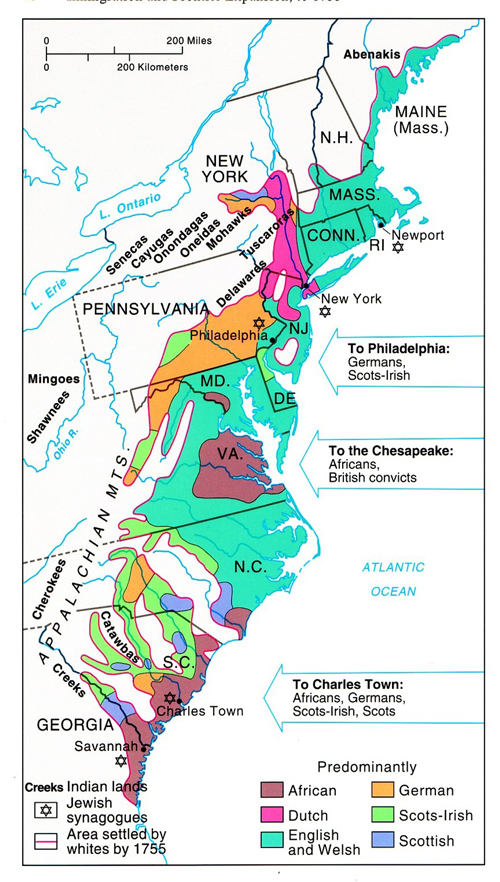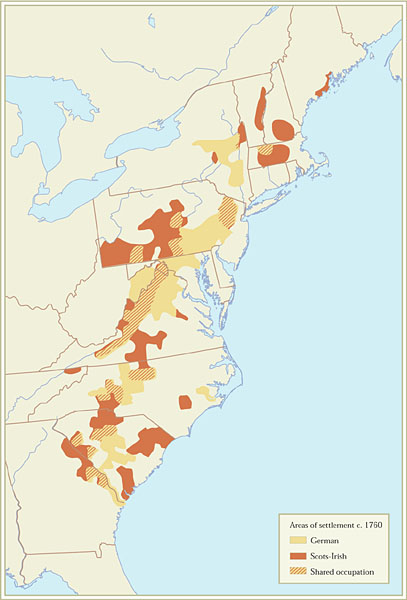Scots-Irish Migration to America

Scots-Irish Invasion
Discuss the relative importance of the Scots-Irish Migration and specifically how that applies to our line of Adams ancestors.
Many thousands of Scots-Irish migrated to the American Colonies prior to 1776, with large-scale immigration beginning in 1718. Immigration to America was at a standstill during the American Revolution (1775-1783), but following the Revolution many Scots-Irish continued to come to the United States. However, this article focuses on the pre-1776 immigrants.
For the purposes of this article, the term “Scots-Irish” refers to settlers who were born in or resided in Ireland but whose earlier origins (whether personal or ancestral) were in Scotland. They have also been called “Scotch-Irish,” “Ulster Scots,” and “Irish Presbyterians.”
Historical Background
Scots-Irish immigrants came from the historic province of Ulster (in the north of Ireland). Scottish settlers began to come in large numbers to Ulster in the early decades of the 1600s. James I, the English monarch, sought to solidify control by transferring land ownership to Protestants and by settling their lands with Protestant tenants (English and Scottish). Scottish settlers continued to come to Ireland throughout the seventeenth and eighteenth centuries.
Scots-Irish immigrants settled in the American colonies from the 1600s. However, the first major migration of Scots-Irish to America was a group that came with Rev. James McGregor from County Londonderry to New England in 1718. They arrived at Boston, and many of them moved to New Hampshire, establishing the town of Londonderry.
The majority of the Scots-Irish who came to America in the colonial period settled in Pennsylvania, Virginia, and the Carolinas. Nonetheless, there was significant Scots-Irish settlement in each of the thirteen American colonies.
Many of the earliest Scots-Irish immigrants (of the 1720s and 1730s) first settled in Pennsylvania. Many then moved down from Pennsylvania into Virginia and the Carolinas. From there immigrants and their descendants went on to populate the states of Georgia, Kentucky, and Tennessee in the 1780s and 1790s.
There are a myriad of possible reasons for the immigration of so many of the Scots-Irish to America in the 1700s. High rents and religious persecution have often been blamed. Most of the Scots-Irish came freely to the American colonies, although there were also some who were deported as prisoners or came as indentured servants. Others came with British Army regiments and remained in the American colonies.
It is important to keep in mind that just because an ancestor came from Ireland to America during the colonial period does not mean that he/she was necessarily Scots-Irish. Many Anglicans, Catholics, and Quakers also came from Ireland during this time period. An ancestor from Ireland can often be identified as Scots-Irish from: family tradition; the surname; the given names in the family; association with other Scots-Irish; or identification as a Presbyterian.
Group/Congregational Migrations
The Scots-Irish migration to colonial America was in family groups, often such that members of an extended family settled near one another in America, whether they immigrated together or separately. Some Scots-Irish immigrants came to America as part of larger group or congregational migrations, meaning that an entire group or congregation of Presbyterians together moved from one locality in Ireland to one locality in America. It is thus very important to trace persons that immigrated with a Scots-Irish ancestor or were associated with the ancestor in America.
In some cases, the immigrating group was led by a minister. In such instances, the minister may be traced back to the church he served in Ireland. Most of the immigrants who accompanied him would be from the same area. However, a group or congregational migration may have drawn from a larger area than just one town or parish in Ireland.
Waves of Scots-Irish Migration
I wanted to share some information about our ancestry. We are starting to really focus in on what seems to be migrations from Ireland and we are probably Scots-Irish in origin meaning we are most likely Scottish but our ancestors were living in Northern Ireland for several generations prior to immigrating to America. Some of our oldest Adams lines in this group came from Ireland and started in Pennsylvania (1750ish), Virginia and South Carolina (1772). I really wanted to start to understand why some of our group (specifically A079) – came in to South Carolina rather than Pennsylvania or Virginia. In order to do that I had to revisit some books on the Scotch-Irish movement to America. I’ll summarize below. If you already know this, then feel free to disregard but it was refreshing form me to go over it again as I had forgotten most of it. Understanding this is key to solving the puzzle we have before us.
The following information comes from “The Scotch-Irish – A Social History by James G Leyburn 1962. Starting on Page 169
There were five great waves of emigration, with a lesser flow in intervening years.
1717-18 The first movement , so significant as a path opener had as its immediate cause the years of drought; but it was the opinion of Archibishop King and Dean Swift that not even the dire effects of bad crops and high prices would have been enough to make the people move if they had not had the added goad of rack-renting, still such a novel practice that it caused intense resentment. . . . in addition to the 5000 or so who went in 1717, there is no means of knowing how many other Ultermen left in this first wave.
1725-29. The second wave was so large that not merely friends of Ireland but even the English Parliament became concerned. Parliament appointed a commission to investigate the causes of the departures, for they had reached proportions that portended a loss of the entire Protestant element in Ulster. Letters of immigrants themselves spoke of rack-rents as the cause. The second wave had so well established the Scotch-Irish in the south eastern tier of counties in Pennsylvania that their influence even in political affairs in the Quaker commonwealth was becoming impressive.
1740-41. Famine struck Ireland in 1740 and was certainly the cause of the third large wave. An estimated 400,000 persons died in Ireland during 1740-41. This wave marked on America side, the first movement of Scotch-Irish in any numbers beyond the confines of Generous Pennsylvania to the southwest following the path through the Great Valley from Pennsylvania through Maryland, Virginia down toward North and South Carolina. (I believe this was the great Wagon Road).
1754-55. The fourth exodus had two major causes: effective propaganda from America and calamitous drought in Ulster. A succession of Governors of North Carolina had made a special effort to attract to that province colonists from Ulster and Scotland.
1771-75. Leases on the large estate of the Marquis of Donegal in county of Antrim expired, the rents were so greatly advanced that scores of tenants could not comply with the demands and so were evicted from farms their families had long occupied. During the next 3 years nearly a hundred vessels carraying as many as 25,000 passengers , all Presbyterian. The two years after that, nearly 30,000 protestants left Ulster.
Page 180 – Total Estimates of the great migration in the 58 years range from 200,000 to perhaps as many as 300,000.
| PA | VA | NC | SC | |
| Effects on settlements began | 1717 | 1732 | 1740 | 1760 |
| Steady inflow | 1718 | 1736 | 1750 | 1761 |
| First Frontier County Organized | 1729 | 1738 | 1752 | 1769 |
| First Inland Presbyterian church | 1720 | 1740 | 1755 | 1764 |
Note from David Scifres: An Aside note, what would become Franklin County (part of Cumberland County) PA was predominately Scotch Irish with a few German townships in 1751 – the Scots-Irish were there first and as time passed it was setteled by Germans more so than when it was started. John Adams (from family A265) and Nancy Agnes Culbertson’s ancesters occupied the area near Chambersburg at this time (it was called Guilford and Falling Springs respectively). The Adams first appear in 1740 and Culbertson family as early as 1733. Both John Adams and Nancy Agnes Culbertson were born there. I’m going to send more on this later as I think I have identified the family of my John Adams A265 and they appear to have come from the Parrish of Cumber in Londonderry, Ulster North Ireland (according to the will of William Adams (from family A364). I knew already that Nancy Agnes Culbertson’s family came from Antrim Ireland and that she and John Adams (from family A265) were cousins – though I have not figured out how they were cousins conclusively yet.
I believe it is highly likely several of the families in family group 033 came from/through this area in Ulster Ireland prior to coming to America. Based on the 1740 protestant census of Londonderry our Adams line appears to have lived in the Barony of Tirkeeran, Parrish of Cumber (Lower) and Townlands of Ballynamore (Ballinamore) and Killenana. There were a bunch of Adams with the same given names also in the Barony of Tirkeeran in the Parrish of Clondermot and I suspect there Adams are related to the Adams of Ballynamore and Killenana. The Culbert family was also densely populated in the Barony of Tirkeeran, Parrish of Faughanvale, Townland of Donnybrewer (Dennybrooer).
Going further back to the 1663 Hearth Money Rolls of Londonderry, Ulster Ireland 10 Adams family men appear with similar given names to our family living in the Parrish of Coleraine, Clondermot, Ballyaghrn and several others.
And as far back as 1630 Muster Rolls for Estates in County Londonderry there are 10 Adams listed in the NW Liberties of Londonderry, Loughinsholin, North East Liberties of Coleraine, and Keenaght. All the given names are David, James, John William Thomas, George and Robert. These are the same as all the Adams in and around Tyrone/Toboyne, Gilford, Chambersburg, Falling Springs in early Cumberland County PA from 1740-1770s. Their last names in Ireland varied from Adam, Adams and Adamson on the 1630 Muster Roll. There were on the following estates, City & Liverties of Londonderry, Maghera & Desertmartin Chuchlands, Town and Liberties of Coleraine and finally the Haberdashers (Sir Robert McClelland).
In the 1622 Muster Rolls for the City and Liberties of Londonderry, Town and Liberties of Coleraine and the Vintners’ Estate – there appears on only one Adams – William Adams on the Estate of Coleraine, North East Liberties of Coleraine.
For more you should read the page about Ulster Ireland here – http://adamsfamilydna.com/2013/02/23/parrish-of-cumber-in-londonderry-ireland/.
Page 252 – The Tidewater South, speaking on South Carolina. By 1763, when the province had become interested in attracting settlers into the up-country, a bounty was offered to stimulate immigration. This consisted of a “headright” of a hundred acres for each man, with fifty acres for each woman and child. (This means we can find out the family make up of the records in those ship logs by doing the math.) The government, moreover, supplied the arrivals with “The most indispensable implements of agriculture. This bounty was offered just as the Scotch-Irish from Pennsylvania and Virginia had reached the upper Piedmont by wa of North Carolina. There was a valid reason for sailing straight from Belfast to Charleston, instead of landing at Philadelphia and traversing the seven hundred miles of the Great Wagon Road. “Scare a ship sailed” from any port in Ireland for Charleston, we are told “That was not crowded with men, women and children.”